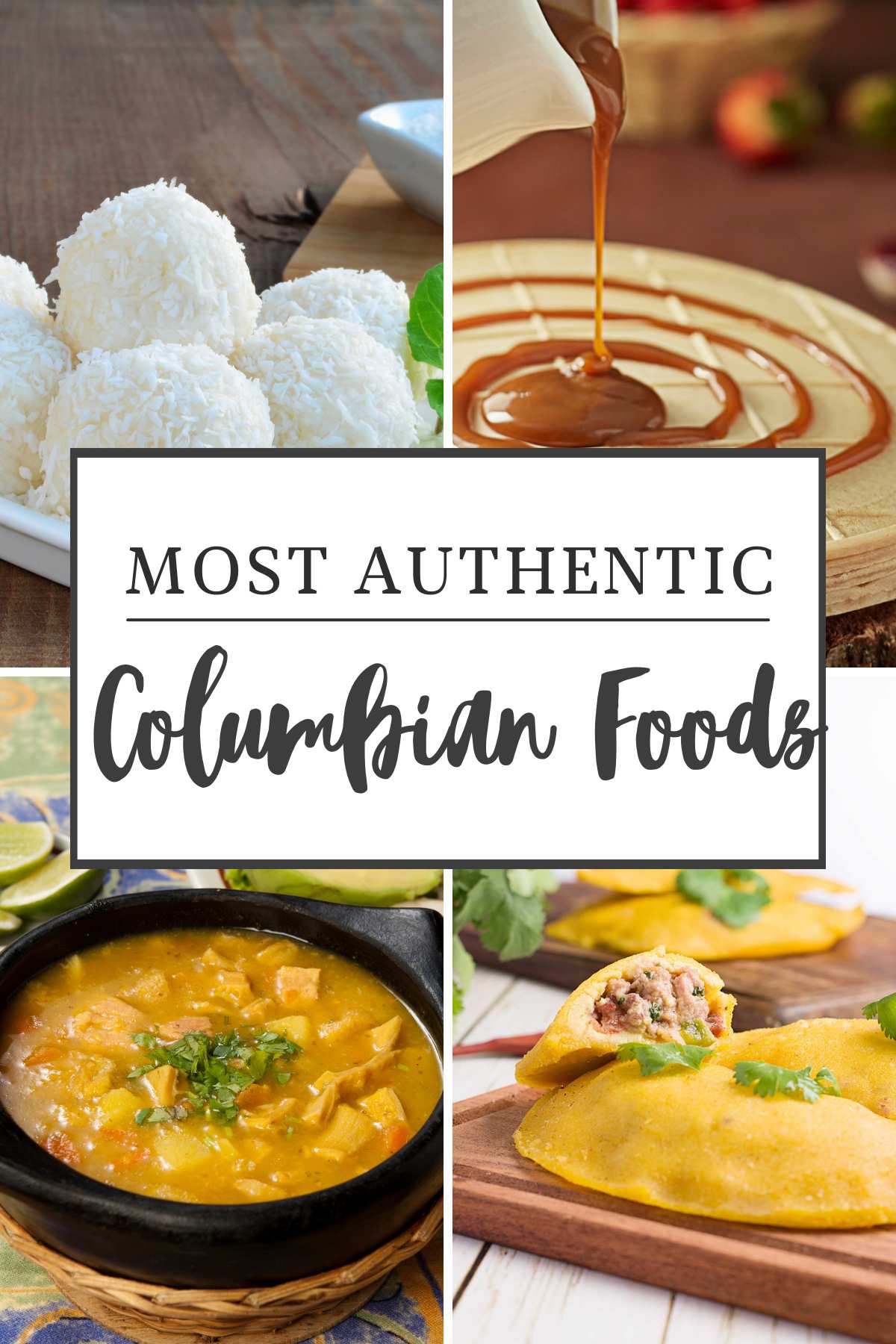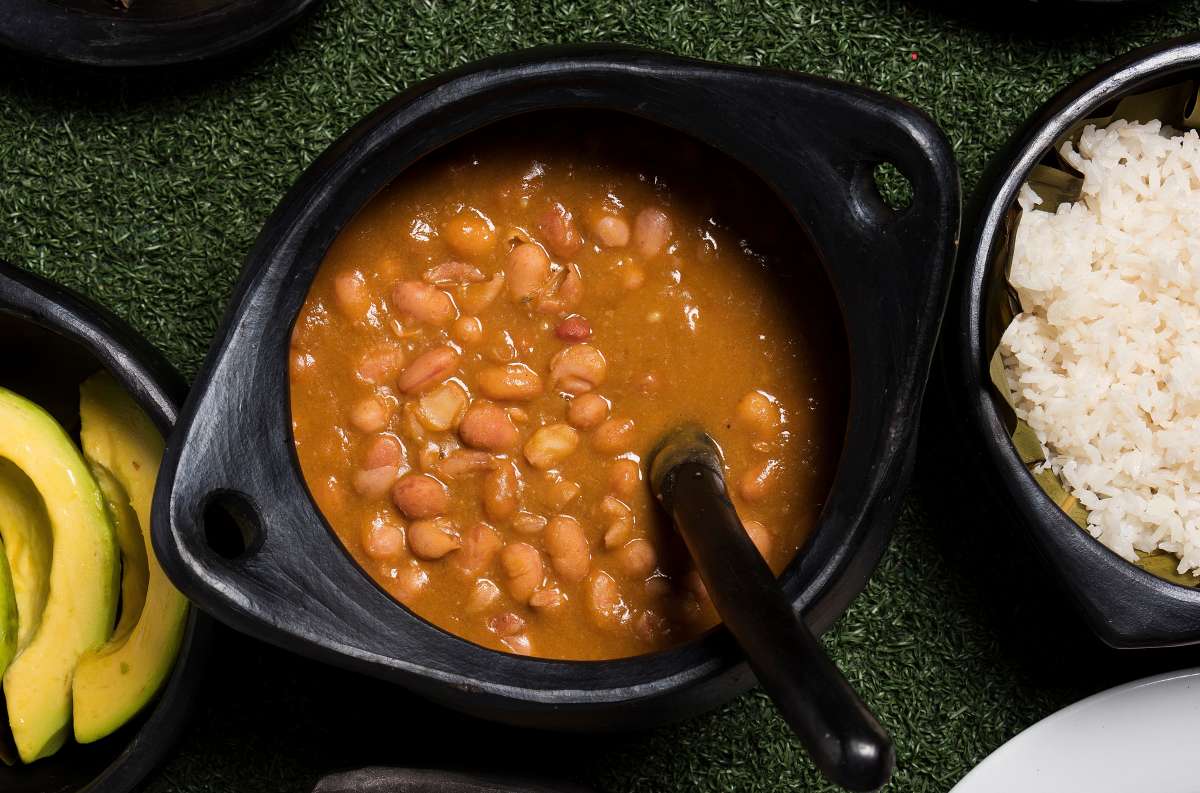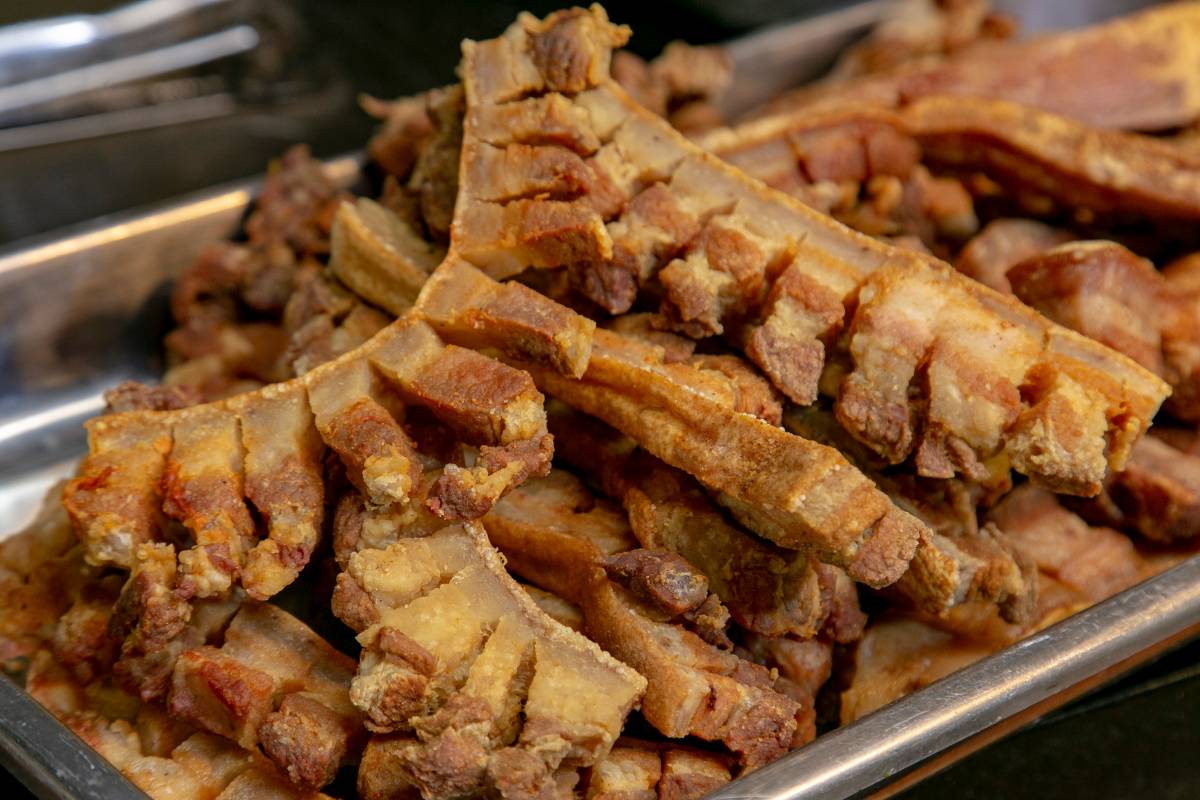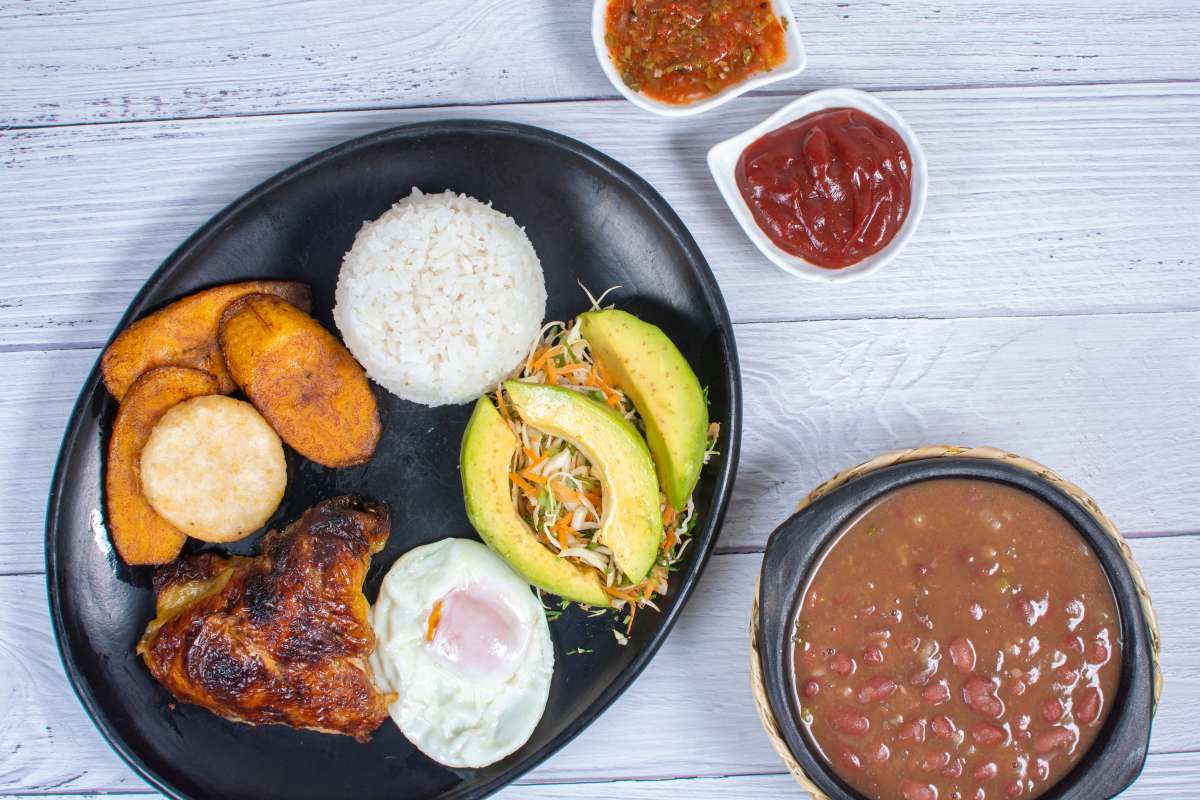The Top 28 Most Authentic Colombian Foods You Have To Try
Colombian cuisine is a culinary treasure trove that will leave you craving for more.
From savory delights like Bandeja Paisa and Colombian Empanadas to sweet indulgences like Pandebono and Bananos Calados, the flavors of Colombia will take your taste buds on a captivating journey.

The diversity of traditional Colombian food is another aspect that sets it apart. From hearty platters featuring an array of meats, rice, beans, and avocado, to comforting soups like Sopa De Pollo, infused with the flavors of plantains, corn, and yuca, there is something to satisfy every craving.

So, whether planning a trip to Colombia or simply exploring new culinary horizons, prepare yourself for a taste sensation like no other. For more articles like this, check out Best Food Trinidad and Tobago or Best Food From Curacao.
Bandeja Paisa
The Bandeja Paisa is a must-try dish for anyone visiting Colombia, as it showcases the rich and diverse flavors of the country’s cuisine.
This classic Colombian food consists of fried pork belly, red beans, white rice, plantains, chorizo sausage, avocado, and a fried egg on top.
The combination of savory meats with the sweetness of the plantains and the richness of the fried egg, make for an unforgettable culinary experience.
If you’re looking to explore authentic Colombian food culture, then be sure to indulge in this delicious plate on your next visit to Colombia!

Colombian Empanadas
You can’t resist sinking your teeth into these savory and crispy Colombian empanadas. They’re a must-try if you’re searching for traditional Colombian food.
These deep-fried pockets of corn flour dough are filled with a delicious mixture of ground beef, potatoes, onions, and spices.
Empanadas are a staple street food in Colombia and come in many different regional varieties, each with its own unique flavor profile.
Trust me when I say that one bite of these empanadas will transport you straight to the bustling streets of Colombia. Also, have a look at 13 Best Empanada Doughs, or Best Empanada Fillings.

Frijoles Rojos
Now, if you’re craving something hearty and delicious, why not try frying up some Frijoles Rojos? These red beans are a staple in traditional Colombian food and are often served as a side dish with white rice, meat, and plantains.
What makes these beans so unique is the way they’re cooked – slowly simmered with onions, garlic, tomatoes, and spices until they become tender and flavorful.
They have a rich, earthy taste that pairs perfectly with other popular Colombian foods like empanadas or arepas.
Frijoles rojos represent some of the best Colombian food out there, showcasing the country’s love for simple yet delicious ingredients. So next time you’re looking to expand your culinary horizons or just want to indulge in some classic comfort food, give frijoles rojos a try!

Pandebono
If you’re in the mood for a cheesy and chewy snack, try making pandebono at home. This traditional Colombian food can be found on street food vendors all over the country, and is perfect as a side dish or afternoon snack.
Pandebono is made with corn dough, cheese, eggs and butter. To make it at home, mix the ingredients together until you have a smooth dough, then shape it into small balls or disks. Bake until it turns a beautiful golden color and savor it while still warm with a delightful cup of tea.
Pandebono is one of my favorite Colombian foods because it’s so easy to make and tastes delicious! Top Haitian Breakfasts, or Top Chilean desserts.

Bananos Calados
When making bananos calados, don’t forget to coat the plantain slices in cinnamon and sugar before frying them to create a sweet and crispy snack.
This traditional Colombian dish is made by simmering fried plantains in a mixture of water, panela (unrefined cane sugar), and sweetened condensed milk until the sauce thickens and caramelizes.
The result is a deliciously decadent dessert that perfectly balances the sweetness of tropical fruits with the warmth of cinnamon spice.
As one of Colombia’s most beloved traditional foods, bananos calados can be found in street markets and restaurants throughout the country, where they are often served as an afternoon snack or after-dinner treat.

Chicharron Colombiano
To make chicharron Colombiano, you’ll need pork belly that’s been boiled until tender. Then it’s deep-fried to create a crispy and flavorful snack. This dish is often served with fried green plantains or arepa de huevo, making for a savory meal.
It pairs well with arroz con coco and a sweet treat like dulce de leche for dessert. To round out the experience, enjoy it all with a refreshing drink. The combination of textures and flavors in this dish truly showcases the richness of Colombian food.

Pescado Frito
Get ready to indulge in the crispy and flavorful delight of pescado frito. This popular deep-fried fish dish will transport your taste buds straight to the heart of Colombian food.
The dish is usually served with fried egg on top, with coconut milk, rice, fresh cheese, and deep fried plantains.
If you’re looking for an authentic Colombian experience, make sure to try this delicious dish!

Tamales
You have to try the tamales, they’re a staple in Colombian food and you won’t regret it. These traditional Colombian corn cakes are made with masa harina, pork or chicken, and wrapped in banana leaves before steaming.
The result is a savory and delicious treat that is perfect for breakfast or lunch. Tamales can also be sweetened with shredded coconut or other fruits for a dessert option. They’re often served with hot chocolate or coffee, making them the perfect comfort food on a cold day.
If you’re looking to experience the best of Colombian foods, then tamales should definitely be on your list!

Ajiaco
If you’re in Colombia, you gotta try the ajiaco – it’s seriously delicious!
Ajiaco is a traditional Colombian dish that is essentially a chicken soup with potatoes, corn on the cob, and capers. It’s typically served with cream and avocado on top, giving it an added creamy texture.
The flavors of this dish are unbeatable – the broth is rich and flavorful from being simmered for hours with ingredients such as garlic and onion. You can find variations of this dish throughout Colombia but each one has its own unique twist.
Overall, if you want to experience one of the best Colombian foods out there, give ajiaco a try!

Maracuya
When visiting Colombia, don’t miss out on trying maracuya, a passion fruit that is bursting with flavor and commonly used in drinks and desserts.
This tropical fruit has become a staple in traditional Colombian dishes and is considered one of the best Colombian foods. The sweet and tangy taste of maracuya adds a unique twist to any dish it’s incorporated into.
Whether trying it as a refreshing juice or a topping on your dessert, you’ll quickly understand why Maracuya is so beloved in Colombian cuisine.
So make sure to add this delicious fruit to your list of must-try foods when exploring all that Colombia has to offer!

Colombian Coffee
Get ready to experience the rich and bold flavor of Colombian coffee, a staple in the country’s culture and economy.
Colombian coffee is known for its high-quality beans that are grown in the Andean region of Colombia.
For those who prefer something sweeter, try a cup of Colombian hot chocolate made from melted chocolate bars mixed with milk and sugar.
Overall, Colombian coffee is not only delicious but also plays an important role in Colombia’s history and economy.

Coconut Rice
You’ll love the creamy texture and subtle sweetness of coconut rice, a must-try side dish in Colombian cuisine. This delicious Colombian food is a staple in traditional Colombian meals, often served alongside grilled meats or fish.
The secret to its rich flavor lies in the use of coconut milk and shredded coconut, which give it a unique taste and aroma. In fact, many food tours in Colombia highlight this dish as one of the best Colombian dishes to try.
If you’re looking for an authentic taste of Colombia, be sure to add coconut rice to your list of must-try foods!

Arepa
Get ready to delve into the irresistible world of Colombian cuisine with Arepas, the quintessential savory corn cakes. Bursting with a variety of fillings such as succulent beef, tender chicken, or melt-in-your-mouth cheese, these golden treats are fried until they reach the pinnacle of perfection.
Picture yourself seated at a Colombian table, relishing your Arepas along with a comforting bowl of traditional Colombian soup – a gastronomic duo that narrates the vibrant culinary story of Colombia.
Don’t be surprised if you find yourself lost in the unique textures, the crisp exterior beautifully complementing the soft inside. With every bite, you’re not just tasting an Arepa, you’re partaking in a Colombian cultural celebration.

Colombian Buñuelos
Indulge in the delectable Colombian buñuelos – soft and doughy balls of cheesy goodness that will leave your taste buds dancing with joy. These little treats are a staple during holiday seasons, but they can be enjoyed any time of year.
They’re made with a combination of yucca flour, cornmeal, eggs, and cheese, which gives them their signature flavor and texture. Have them as a snack or pair them with some hot chocolate for an extra special treat. Trust me; it’s the perfect combination!
If you’re feeling adventurous, try dunking them in chicken soup or pairing them with passion fruit for an unexpected twist on this classic dish. No matter how you choose to enjoy them, Colombian buñuelos are sure to become one of your favorite Colombian foods alongside other traditional dishes like arepa de huevo and corn cakes.

Sopa De Pollo
Get ready to savor the comforting warmth of a bowl of Sopa De Pollo, a traditional Colombian chicken soup that’s perfect for chilly days.
This delicious soup is made with tender chicken, potatoes, carrots, onions, cilantro and garlic.
In some regions of Colombia, it’s also common to add ground meat or corn cakes called arepas to the soup. The Caribbean coast even has its own version with coconut milk!
For dessert, make sure to try some passion fruit or pair it with a cup of hot Colombian chocolate for the ultimate experience.
Trust me, one spoonful will transport you straight to the heart of Colombia!

Morcilla
The Morcilla is a savory Colombian blood sausage made with rice and spices. It’s a staple in Latin American cuisine.
The sausage is typically made with ground meat and mixed with cooked rice, onions, garlic, and various spices such as cumin and paprika.
Morcilla can also be served sliced on top of arepas (corn cakes) or as an ingredient in other popular Colombian recipes.

Cazuela De Mariscos
You’ll be delighted by the complex flavors of Cazuela De Mariscos, a seafood stew that is considered one of the best Colombian foods.
This hearty dish is especially popular along the Caribbean coast and is often referred to as a national dish.
It features an array of fresh ingredients, such as shrimp, crab, clams, octopus, and squid, simmered in a savory broth with potatoes, plantains, corn on the cob, garlic, onions, and spices such as cumin and saffron.
Whether you’re looking for a comforting meal on a rainy day or simply want to indulge in some authentic Colombian cuisine, Cazuela De Mariscos is definitely worth trying!

Lechona
When you’re in Colombia, don’t miss out on trying the delicious Lechona, a traditional dish that is one of the most popular Colombian dishes.
The Colombian version of this dish is made by slow cooking minced meat and rice inside a pig’s stomach, resulting in a succulent and flavorful meal. The preparation process can take up to 10 hours, but it’s worth the wait as the pork becomes tender and juicy while absorbing all of the spices used in seasoning. The crispy skin adds an extra layer of texture to each bite.
It’s usually served with sides such as arepas or plantains and is typically enjoyed during special occasions like weddings or holidays.
Don’t leave Colombia without savoring this delectable traditional dish!

Obleas
If you’re looking for a sweet treat in Colombia, try some obleas. These thin wafers are filled with delicious dulce de leche, fruit, and whipped cream that will satisfy your sweet tooth.
But what really sets obleas apart is the variety of toppings available. You can choose to add melted cheese or guava paste to your oblea for a unique twist on this traditional dessert. And if you’re feeling adventurous, try an oblea with pan de arepa or pan de bono – deep fried versions of these popular Colombian snacks.
No matter what toppings you choose, be sure to top it off with some Colombian caramel for the perfect finishing touch.

Carimanola
One of the most popular snacks in Colombia is the carimanola, a traditional dish made from green plantain and filled with minced meat and vegetables. This savory treat is deep-fried to perfection!
The stuffing inside can vary depending on personal preference, but typically includes ground beef or pork mixed with onions, garlic, and spices like cumin and paprika. What makes the carimanola unique is its versatility – it can be enjoyed as a hot snack straight out of the fryer or served cold as an appetizer at parties or gatherings.
Overall, this Colombian food staple is one you won’t want to miss out on during your culinary adventures in South America.

Colombian Sopa De Mondongo
To experience a rich and hearty dish that will warm your soul, try Colombian sopa de mondongo. This slow-cooked stew is made with tripe, vegetables, and spices – a combination of flavors that creates a truly unique taste.
What sets it apart from many Colombian dishes is the use of mondongo, or beef tripe. The texture may seem unusual at first, but it adds an earthy flavor and chewy consistency to the dish.
To balance out the strong flavors, sopa de mondongo is often served with fresh fruit for dessert or topped with whipped cream for extra richness. Overall, this dish exemplifies the boldness and complexity of Colombian cuisine.

Arroz Con Pollo
You can’t go wrong with a classic dish like arroz con pollo, which is one of the most popular Colombian foods.
This hearty meal typically consists of tender chicken pieces slow cooked in a savory broth with onions, garlic, and spices. The chicken is then mixed with flavorful rice that has been slow cooked in the same broth to create a comforting one-pot meal that’s perfect for any occasion.
While this dish has its roots in Peru and is also common throughout Caribbean food cultures, the Colombian version often includes additional ingredients such as peas, carrots, and red peppers.
It’s typically served with a side salad or fried plantains to add even more flavor and texture to the meal.
Aborrajados
If you’re craving a sweet and savory snack, try the Aborrajados. This Colombian food version of a Peruvian dish is a delicious treat made with ripe plantains, melted cheese, and sometimes meat or shrimp.
The plantains are sliced lengthwise and stuffed before being battered and fried. The dish has its roots in Caribbean food culture but has become popular throughout South America as well.
Aborrajados are often served alongside lime juice or paired with other traditional dishes like Colombian shrimp ceviche. They make for an excellent snack or even as part of a meal.

Bocadillo
Bocadillo is a popular snack in Colombia made from guava paste that’s cooked down until it’s thick and sticky.
The texture is soft and chewy, almost like a fruit leather, but with more depth of flavor. Bocadillo is typically served with cheese, creating a perfect balance between the sweet guava filling and salty cheese.
It’s also common to find Bocadillo as a filling inside pastries or empanadas, adding an extra layer of deliciousness to these savory treats.

Cocadas Blancas
Indulge in the mouth-watering goodness of Cocadas Blancas, a traditional coconut candy from Colombia that will transport your taste buds to paradise.
These sweet treats are made with grated coconut, sugar, and coconut milk, resulting in a chewy texture and a rich coconut flavor that is impossible to resist.
The candies are usually shaped into small rounds or balls.
Trust me, once you try these delicious treats, you’ll never want to go back to boring old candy again!
If you like it sweet, check out some more delicious desserts from Colombia!

Colombian Hot Chocolate
You can warm up on a chilly day by sipping on a cup of creamy, chocolatey Colombian hot cocoa that’ll make you feel like you’re sitting in a cozy café in Bogotá.
This delicious drink is made with Colombian chocolate, known for its rich flavor and high quality. The cocoa is mixed with milk and sugar to create a smooth and velvety texture that melts in your mouth.
Some people like to mix in cinnamon or vanilla to add an extra layer of flavor.
The best way to enjoy this drink is with some traditional Colombian treats like buñuelos or pandebonos.
Whether you’re snuggled up at home or exploring the streets of Colombia, a cup of hot cocoa is the perfect way to explore the country’s amazing cuisine.

Calentado
Calentado is a savory dish that combines rice, beans, and meat to create a hearty meal that is popular in Colombia. It’s typically made with leftover ingredients from the previous day’s meals and served for breakfast or lunch.
The dish gets its name from the Spanish word ‘calentar,’ which means to warm up or reheat. To make calentado, you start by frying up some onions and garlic in oil before adding cooked rice and beans to the mix. Then, you add your choice of meat (usually pork or sausage) along with any other leftover vegetables red beans you have on hand.
Finally, everything is mixed together until it’s heated through and ready to serve. The result is a filling meal that’s packed with flavor and perfect for fueling up for the day ahead.

Fried Ripe Plantain
If you’re looking for a side dish to complement your meal, try frying up some sweet and savory plantains.
Fried plantain, or Platanos Fritos, is a staple in Colombian food and can be found at almost any restaurant or street vendor.
The plantains are sliced diagonally and fried until they turn golden brown. They can be served as a side dish with rice, beans, meat, or fish, or even enjoyed as a snack on their own.
What makes them so delicious is the contrast between the slightly caramelized sweetness of the plantain and the pinch of salt added during frying that brings out its flavor.
Whether you’re new to Colombian cuisine or have been enjoying it for years, deep fried plantains are a must-try addition to any meal.

Conclusion
In conclusion, I have to say that Colombian cuisine is truly a feast for the senses.
The Colombian Empanadas, with their crispy exterior and rich filling or frijoles rojos, are a staple in many households, and packs a punch of protein and carbohydrates to fuel your day.
If you haven’t had enough and are looking for some additional Colombian delicacies, check out this Colombian Sancocho or these delicious breakfast cheese arepas.



